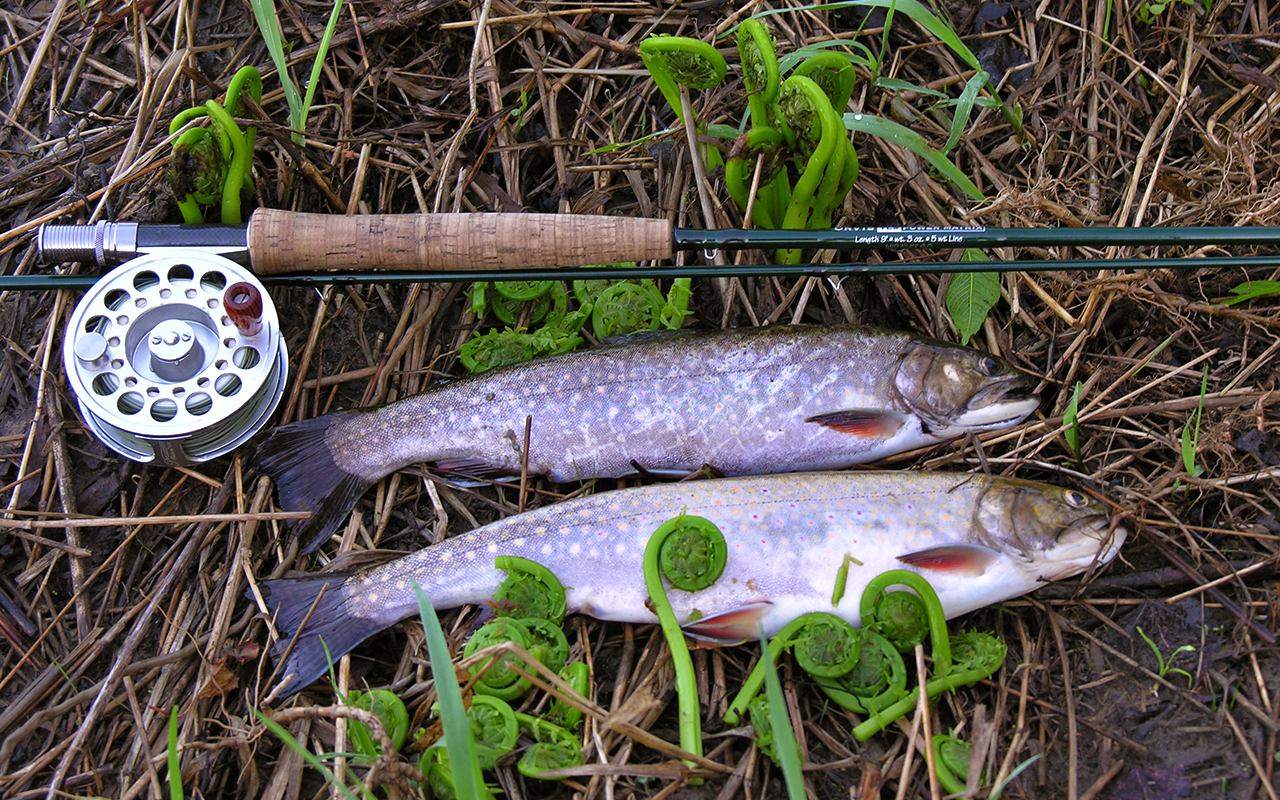
Most everyone born and raised in Aroostook County knows May is fiddlehead month, a limited-time treat that’s a true Crown of Maine tradition. If there’s a fisherman in the family, or a friend or neighbor who will share his catch, the annual combo of fried brook trout and fresh fiddleheads can be enjoyed for a short time. Since some of the most productive fiddlehead plants are located along regional rivers and streams, it’s possible to acquire both meal ingredients in one trip.
I’m sure I’m not the only outdoorsman to go fishing and by sheer luck stumble across a patch of curled greens. Many is the time I’ve taken 10 minutes to stop and fill my hat full of fiddleheads, just the right amount for four heaping, steaming bowls to go with the trio of tasty brookies in my creel. A couple of my friends actually plan ahead, take along a small mesh trout net and place their picked fiddleheads in the net and then dip and swish it in the brook current to clean and wash them.
Fiddleheads are actually an ostrich fern most prominent in the Northeast and most of Canada, and not only do they have a short spring season, but are in prime, tightly wound heads for only four to six days. If not snapped off a couple of inches below the scroll-shaped head when the stalk is 3 to 8 inches high, the plant will soon unfurl and turn into a leafy green fern of no taste or table value.
Forward-thinking fishermen will select a local brook that’s likely to boast fiddlehead-lined shores, pack a couple of plastic bags in their fishing vest pocket and enjoy a two-for-one outing. The Aroostook River is a prime site for fish and fiddleheads and easily accessible at hundreds of locations. From creeks and marshland near Oxbow, the Aroostook wanders through or near a dozen towns and villages before exiting into New Brunswick at the Fort Fairfield town line.
Right off Route 1 in Presque Isle is a boat ramp and parking area large enough for 10 vehicles and boat trailers. It’s near the local mall beside the bridge. Several other communities also offer similar easy-access fish and forage locations, but due to heavy pressure experienced pickers bring a boat or canoe and motor up or downstream. Not only will a watercraft allow access to more remote areas for trout and greens, islands that are covered with fiddleheads and seldom visited can be explored.
The Prestile Stream from Easton to Bridgewater, Meduxnekeag in Houlton, Fish River in Fort Kent, Little Madawaska River north of Caribou and St. Croix Stream all have miles of top-rate fiddlehead shoreline to explore, some much simpler to reach than others, but all productive and worthwhile. All these waterways also offer great brook trout fishing on a fly, lure or bait.

At this time of year it’s not uncommon to catch a couple of trout and then find a plot of fiddleheads along the stream. The author uses his hat to collect some tasty greens. (Courtesy of Bill Graves)
Let’s discuss preparing and cooking fresh brook trout.
Since no preparation beats camping out and cooking over an open fire, my second choice is pan frying at home with cleaned, headless fresh trout, patted dry, dredged in cornmeal and fried in a cast iron pan greased with salt pork, turned until cooked through, flaky, and with the skin crisp. Occasionally, I like a different flavor to the already delicious pink meat, so I make trout almandine.
Wash and pat dry eight 10- to 12-inch trout and sprinkle the body cavities lightly with salt and pepper. Beat two eggs and 1/2 cup of light cream or half and half together in a shallow pan, then dip each fish in the mixture and dust in flour from a 1/2-cup portion in a second pan. Over low heat, saute 1/2 cup slivered almonds in 2 tablespoons of butter until lightly browned. Now add 4 tablespoons of lemon juice and half a teaspoon of tarragon, heat through, then remove from burner and keep warm.
Cook your trout in a skillet with ¼ cup olive oil and 1 tablespoon of butter. Fry and turn trout, monitor closely, depending on size, until meat flakes easily with a fork. Place brook trout on a serving platter and pour almandine mixture over all portions, share with friends and enjoy a true taste treat. A side dish of steamed, seasoned fiddleheads adds to the flavor feast.
If you’re one of many Mainers who enjoy trout for breakfast, I’ve got a recipe for a fiddlehead omelet that pairs perfectly and is quick and easy to prepare.
4 teaspoons butter
1 ½ cups fresh, cleaned fiddleheads
1 clove minced garlic
¼ teaspoon salt
¼ teaspoon pepper
6 eggs
1 tablespoon milk
1 tablespoon water
1 tablespoon chopped fresh chives
Melt half the butter in an 8-inch non-stick frying pan over medium heat. Saute fiddleheads, garlic and a pinch of salt and pepper until tender crisp (about 3 minutes) then place them in a bowl and set aside.
Melt 1 teaspoon of butter in the same pan over medium heat. In a bowl, lightly beat the eggs, milk and remaining salt and pepper; pour half in the skillet and cook, gently lifting edges to allow uncooked egg to seep underneath and cook until almost set, about 3 minutes.
Spoon half of the fiddlehead mixture on half the omelet then fold the uncovered half over the top and cook for one minute then place on a plate, sprinkle with chives and serve. Cook a second omelet with remaining ingredients.
Occasional rain showers amidst warm, sunny days have the fiddleheads popping and the trout rising, so get out and enjoy some Aroostook tastes and traditions.




